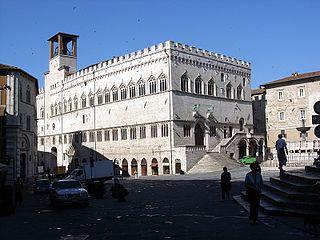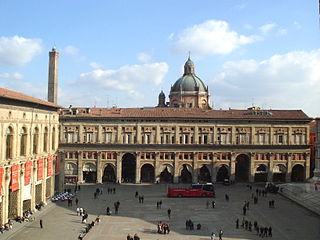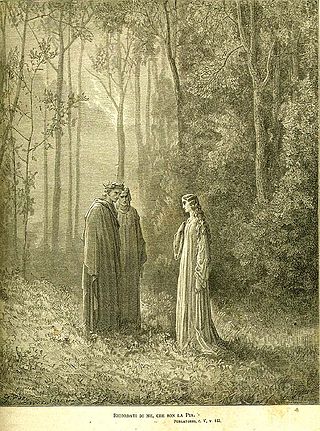The Palazzo Tolomei is an imposing, Gothic style urban palace, located on Via Banchi di Sopra in the present contrada of Civetta, Terzo di Camollia of the city of Siena, region of Tuscany, Italy.

The Palazzo Tolomei is an imposing, Gothic style urban palace, located on Via Banchi di Sopra in the present contrada of Civetta, Terzo di Camollia of the city of Siena, region of Tuscany, Italy.

The building is one of the oldest palaces in the city and was erected between 1270 and 1275 by the Tolomei family. It served as the first permanent headquarters of the Sienese commune during the early years of the Guelph era, before the construction of the Palazzo Pubblico in the Piazza del Campo, and it also functioned as a bank and private residence. [1] It stands on the west side of the Piazza Tolomei, across from the church of San Cristoforo. The aristocratic Tolomei family for many years was associated with this parish church. [2] On the Via Banchi di Sopra, it is a few houses south and across the street of the Palazzo Bichi Ruspoli, a few blocks north of the Piazza del Campo.
The original palace of this Guelf aristocratic family was mostly destroyed by Ghibelline mobs in 1267 but was rebuilt in its current form shortly after the new Guelph regime came to power. The stone palace, with its tall first floor, mullioned windows with trefoil decoration in upper floors, was restored in the 1960s and is now home to Banca CR Firenze.
Among the most notable members of the Tolomei family was Pia Tolomei, who lived in the thirteenth century. In 1295, however, she was supposedly murdered by her Guelph husband from the Maremma, who wished to remarry. Her story was popular in the 19th century as a symbol of faithfulness to principles in the face of treachery and self-interest. Gaetano Donizetti made her the subject of his tragic opera, Pia de' Tolomei. She was initially immortalized by Dante, who encounters her in Purgatory: [3]

- Ricorditi di me, che son la Pia:
- Siena mi fe', disfecemi Maremma:
- Salsi colui che innanellata pria,
- Disposato m'avea con la sua gemma.
- Remember me, who am the Pia;
- Siena made me, but the Maremma unmade me:
- He who had engaged with his ring me first,
- Disposed of me from his jewel.
The Tolomei family also bore Saint Bernardo Tolomei and the Blessed Nera Tolomei, memorialized in the facade of the church of San Cristoforo. In front of the palace stands a column crowned with a Roman She-wolf.

Grosseto is a city and comune in the central Italian region of Tuscany, the capital of the Province of Grosseto. The city lies 14 kilometres from the Tyrrhenian Sea, in the Maremma, at the centre of an alluvial plain on the Ombrone river.

Piazza del Campo is the main public space of the historic center of Siena, a city in Tuscany, Italy, and the campo regarded as one of Europe's greatest medieval squares. It is renowned worldwide for its beauty and architectural integrity. The Palazzo Pubblico and its Torre del Mangia, as well as various palazzi signorili surround the shell-shaped piazza. At the northwest edge is the Fonte Gaia.

Pienza is a town and comune in the province of Siena, Tuscany, in the historical region of Val d'Orcia. Situated between the towns of Montepulciano and Montalcino, it is considered the "touchstone of Renaissance urbanism".

Regola is the 7th rione of Rome, Italy, identified by the initials R. VII, and belongs to the Municipio I. The name comes from Arenula, which was the name of the soft sand that the river Tiber left after the floods, and that built strands on the left bank.

The Republic of Siena was a historic state consisting of the city of Siena and its surrounding territory in Tuscany, central Italy. It existed for over 400 years, from 1125 to 1555. During its existence, it gradually expanded throughout southern Tuscany becoming one of the major economic powers of the Middle Ages, and one of the most important commercial, financial and artistic centers in Europe.

Gavorrano is a mountain-side comune (municipality) in the Province of Grosseto in the western Italian region of Tuscany, located about 100 km (62 mi) southwest of Florence and about 25 km (16 mi) northwest of Grosseto. Gavorrano borders the municipalities of Castiglione della Pescaia, Grosseto, Massa Marittima, Roccastrada and Scarlino.

The Palazzo dei Priori or comunale is one of the best examples in Italy of a public palace from the communal era. It is located in the central Piazza IV Novembre in Perugia, Umbria. It extends along Corso Vannucci up to Via Boncambi. It still houses part of the municipality, and, on the third floor, the Galleria Nazionale dell'Umbria. It takes its name from the Priori, the highest political authority governing the city in the medieval era.

The Palazzo Comunale, also known as the Palazzo del Popolo of San Gimignano has been the seat of the civic authority in the comune since the 13th century. It is located on the Piazza del Duomo close to the Collegiate Church of the Assumption of the Blessed Virgin Mary. The building and Collegiate Church are at the heart of the medieval town, and are part of the UNESCO World Heritage Site of the "Historic Centre of San Gimignano".

Siena is a city in Tuscany, Italy. It is the capital of the province of Siena. Siena is the 12th largest city in the region by number of inhabitants, with a population of 53,062 as of 2022.

The Corteo Storico is a historical costume parade in Siena, Tuscany, Italy. It takes place before the famous horse race known as the Palio on the 2nd of July and on August 16, each year.

Palazzo Salimbeni is a Gothic style urban palace located on the Piazza Salimbeni, just off Via Banchi di Sopra in the Terzo di Camollia of the city of Siena, region of Tuscany, Italy. The building, associated with an ancient mercantile family of Siena, currently houses the main offices of the Banca Monte dei Paschi di Siena, the oldest bank in the world.

Palazzo dei Banchi is a Renaissance-style palace façade located on the eastern flank of the Piazza Maggiore in the center of Bologna, region of Emilia-Romagna, Italy.

San Cristoforo is a Roman Catholic church located on Piazza Tolomei in the Northern Terzo di Camollia and contrada of Civetta in the city of Siena, region of Tuscany, Italy. Across the piazza from the church is the Palazzo Tolomei, one of the oldest buildings in the city. The Tolomei for many years were associated with the church.

The Palazzo Bichi Ruspoli, or previously Palazzo or Castellare dei Rossi, is an urban palace, located on Via Banchi di Sopra in the present contrada of Civetta, Terzo di Camollia of the city of Siena, region of Tuscany, Italy.

The Palazzo Spannocchi is a Renaissance style urban palace located on the Piazza Salimbeni, just off Via Banchi di Sopra in the Terzo di Camollia of the city of Siena, region of Tuscany, Italy. The building was associated with an ancient mercantile family of Siena.


The Palazzo Palmieri, or Palazzo Nuti, is a Mannerist style urban palace, located on Via del Moro #48 in the present contrada of Civetta, Terzo di Camollia of the city of Siena, region of Tuscany, Italy.
The Palazzo Gori Pannilini is a renaissance-style, located on via Banchi di sopra in the city of Siena, region of Tuscany, Italy.

The Albertoni Spinola Palace, with entrances in Campitelli square n. 2, Capizucchi square and vicolo Capizucchi is located in the 10th District. It was projected and executed by Giacomo Della Porta and Girolamo Rainaldi around the end of 16th century and the first years of 17th century.

Pia de' Tolomei was an Italian noblewoman from Siena identified as "la Pia," a minor character in Dante's Divine Comedy who was murdered by her husband. Her brief presence in the poem has inspired many works in art, music, literature, and cinema. Her character in the Divine Comedy is noted for her compassion and serves a greater program among the characters in her canto, as well as the female characters in the entire poem.